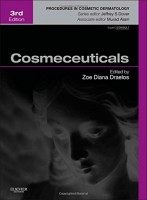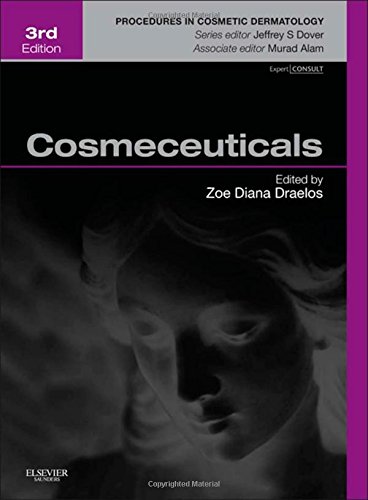 This book is part of the series: Procedures in Cosmetic Dermatology
This book is part of the series: Procedures in Cosmetic Dermatology
Editor: Zoe Diana Draelos, MD; Associate Editor: Murad Alam, MD
Series Editor: Jeffrey S. Dover, MD
Publisher: Elsevier – 221 pages
Book Review by: Nano Khilnani
This compact, handy, useful book has been developed for dermatologists to understand how to use a relatively new category of products known as cosmeceuticals to alleviate skin ailments and diseases. The editors write that these products have become an increasingly important part of therapy in recent years.
This book, as part of the above-mentioned series, is one of 15 distinct volumes that have been published in English and eight other languages over the last seven years. The editors point out that these books have been purchased by thousands of physicians around the world.
Some of the characteristics of the books in this series that the editors are committed to have in them are:
- Practical
- Easy-to-use
- Extremely up-to-date, incorporating all the latest methods and materials
This being its third edition, this book will see newer versions as more discoveries are made and innovations come about. There will also be entirely new books in this series as novel procedures are developed in cosmetic dermatology.
Thirty-five specialists in dermatology and related fields such as biochemistry, clinical research and cosmetic surgery, contributed content to the 29 chapters of this book, which are organized under the five sections named below:
- Defining the Cosmeceutical Realm
- Cosmeceuticals: Function and the Skin Barrier
- Cosmeceutical Formulation Considerations
- Evaluating Cosmeceutical Efficacy
- Cosmeceutical Actives
- Retinoids
- Cosmeceutical Vitamins: Vitamin C
- Cosmeceutical Vitamins: Vitamin B
- Physiologic Lipids for Barrier Repair
- Cosmeceutical Botanicals
- Marine Cosmeceuticals
- Cosmeceutical Metals
- Moisturizer and Barrier Repair Formulations
- Skin Lightening Agents
- Antiaging Benefit Ingredients: AHAs, PHAs, and Bionic Acids
- Stem Cell Cosmeceuticals
- Nutritional Antioxidants
- Endogenous Growth Factors as Cosmeceuticals
- Sunscreens
- Cosmeceuticals and Contact Dermatitis
- The Application of Cosmeceuticals to Dermatologic Practice
- Wrinkles and Fine Lines
- Facial Redness
- Dyspigmented Skin
- Oil Skin
- Dry Skin
- Acne
- Cosmeceutical Myths
- Acne Cosmeceutical Myths
- Cosmeceutical Antiaging Myths
- Botanical Cosmeceutical Myths
- New Research in Cosmeceuticals
- Gene Array Technology and the Search for Cosmeceutical Actives
- Future Cosmeceuticals of Dermatologic Importance
- Summary: What is the Next Horizon for Cosmeceuticals
To get access to the contents of this book and other information, online:
- Login or Sign Up at www.ExpertConsult.com
- Scratch off gray sticker on the inside front cover of this book to get your PIN code
- Enter PIN into the Redeem A Book Code box
- Click on Redeem
- Go to My Library
To give you an idea of the material and its organization that you will find in this book, let’s take a look at chapter 1, Cosmeceuticals: Function and the Skin Barrier, written by Drs. Dasgupta, Bajor, Mazzati, and Misra, all PhDs.
On the top left is a box entitled Summary and Key Facts, with bulleted points. This is followed by the first heading which is the Introduction. The next two headings discuss respectively, the function and structure of the stratum corneum (SC), a semi-permeable layer of the skin.
The living human skin is essentially 70 to 80 percent water, and the SC is a membrane that is “incredibly responsive and adaptive,” the authors write. They assert further that it “is the fundamental evolutionary adaptation that made terrestrial life possible.”
Spread across almost the entire space of the next two pages is a large table that lays out the structure and function of the SC, specifically the key processes, essential features, and significant functions. Also provided in this table are visual diagrams of the maturation of corneocystes, the development of the SC structure, formation of the SC lipid matrix, production of the skin’s natural humectants, and removal of corneocytes by desquamation. So this is quite a detailed description of the stratum corneum.
On the pages that follow are laid out are the macro-structure and micro-structure of the SC, as well as discussion of these topics:
- The mechanics of dry skin
- Effects of the environment on SC function
- UV damage
- Surfactant effects
- SC moisturization
- Role of cosmeceuticals
- The barrier is a challenge for cosmeceuticals
- Future prospects
The chapter ends with References and further reading. Other chapters follow a similar pattern of systematic organization of materials.
Editors:
Zoe Diana Draelos, MD is Consulting Professor in the Department of Dermatology at Duke University School of Medicine in Durham, North Carolina.
Murad Alam, MD, MSCI is Professor of Dermatology, Otolaryngology, and Surgery; and Chief of the Section of Cutaneous and Aesthetic Surgery at Northwestern University in Chicago.
Series Editor:
Jeffrey S. Dover, MD, FRCPC, FRCP is Associate Clinical Professor of Dermatology at Yale University School of Medicine; Clinical Professor at Dartmouth Medical School; Adjunct Associate Professor of Dermatology at Brown Medical School; and Director of SkinCare Physicians in Chestnut Hill, Massachusetts.







